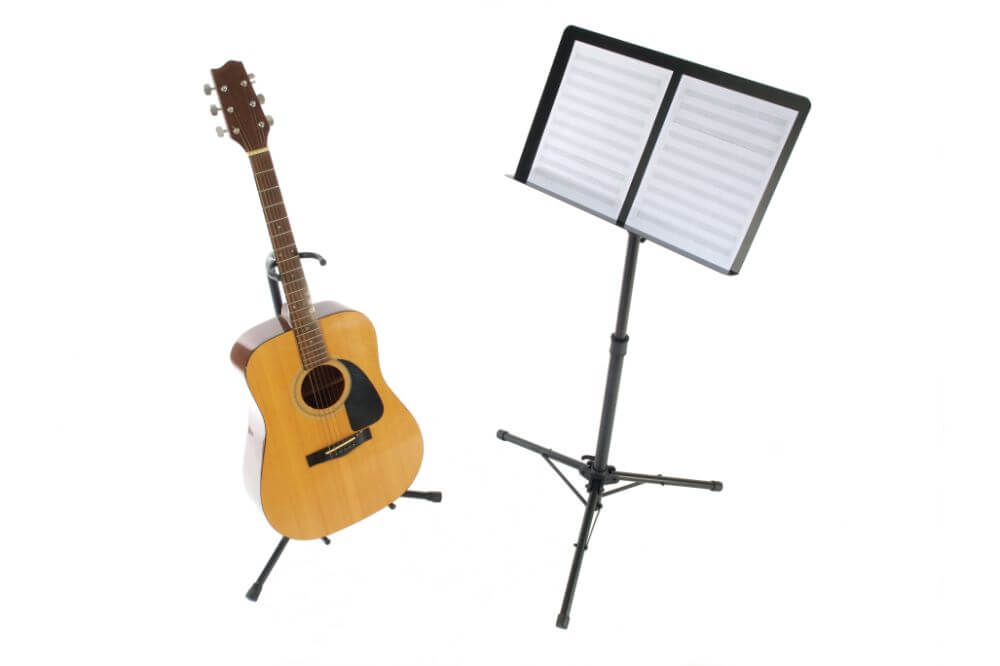There is no right or wrong answer to this question – it all depends on your personal preference! Some guitar players prefer to leave their instrument on a stand, while others like to put it in its case when they’re not playing.
There are pros and cons to both options. In this blog post, we will discuss the benefits of leaving your guitar on a stand, as well as the drawbacks. We hope that after reading this post, you will have a better idea of what is best for you and your instrument!
What are the benefits of leaving your guitar on a stand?
There are many benefits to leaving your guitar on a stand when you are not using it. For one thing, leaving your guitar in its stand ensures that it stays in good condition.
Due to its delicate nature, a guitar is prone to scratches and dents if left out in the open. By keeping it on a stand, you can prevent this damage and ensure that your beloved instrument stays safe and sound. In addition, keeping your guitar on a stand allows for better ventilation.
Because guitars are made of wood and need to be kept at an optimal humidity level, exposure to moisture can be potentially damaging over time. Storing your guitar on its stand helps to prevent this by allowing air to circulate around and through the instrument, which promotes a healthy environment for the wood.
Overall, then, there are many advantages to keeping your guitar on a stand when it’s not being used, from protecting against damage to providing proper ventilation for the instrument itself. So if you want to keep your guitar in top shape for years to come, it’s definitely worthwhile to put it on a stand when not in use!
What are the drawbacks of leaving your guitar on a stand?
Leaving your guitar on a stand can have some drawbacks. For one, the weight of the guitar may cause it to slowly slide down the stand over time. This can lead to dings and scratches in your instrument as well as snapped strings or loosened tuning pegs.
Additionally, leaving your guitar out in the open can make it vulnerable to dust and other contaminants that can damage the finish over time. Other potential problems include accidental knocks from passing objects or pets and faulty stands that may collapse without warning.
Ultimately, while there are many benefits of leaving your guitar on a stand, it is important to be aware of these potential drawbacks so that you can take the necessary steps to protect your instrument at all times.

What is best for you and your instrument – leaving it on a stand or putting it in its case?”
There is no easy answer to the question of whether it is better to leave your instrument on a stand or put it in its case.
On one hand, leaving your instrument out in the open may make it more readily accessible and thus more convenient for practicing. However, leaving your instrument out on the stand may also leave it vulnerable to dust, debris, and other contaminants that put extra stress on your instrument.
Additionally, leaving your instrument exposed on a stand could potentially lead to accidental damage from things like unexpected spills or dropping things on it.
The best course of action may depend on your specific situation and the type of instrument you play. For example, if you have young children who tend to be rough with their toys or like to toss things around, then perhaps keeping your instrument in its case would be a safer option.
Alternatively, if you are constantly finding yourself grabbing for your instrument only at the last minute as you are running out the door for a performance or lesson, leaving it out and ready might be preferable to digging through a case.
Ultimately, which option is best will depend on what works best for you and how well you can take care of your instrument over time. So do some careful consideration before making a decision – because after all, your instrument is an investment that deserves to be protected!
Conclusion
If you’re a guitar player, you’ve probably wondered at one point or another whether it’s better to leave your guitar on a stand or put it in its case when you’re not using it.
Both options have their advantages and disadvantages, so it’s important to weigh the pros and cons before making a decision. Ultimately, the best course of action will depend on your specific situation and the type of instrument you play.
So do some careful consideration before making a decision – because after all, your instrument is an investment that deserves to be protected!




















